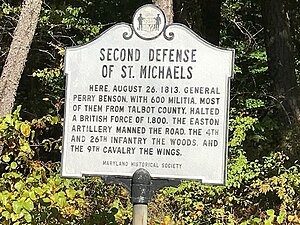| Second Battle of St. Michaels | |||||||
|---|---|---|---|---|---|---|---|
| Part of the War of 1812 | |||||||
 | |||||||
| |||||||
| Belligerents | |||||||
|
|
| ||||||
| Commanders and leaders | |||||||
|
George Cockburn Thomas Sydney Beckwith | Perry Benson | ||||||
| Units involved | |||||||
|
Royal Navy * 1st Bn Royal Marines * 2nd Bn Royal Marines British Army * 102nd Regiment of Foot |
12th Maryland Brigade * 4th Maryland Regiment * 26th Maryland Regiment * 9th Cavalry District | ||||||
| Strength | |||||||
|
Land: 2,100 | Land: 500 | ||||||
| Casualties and losses | |||||||
| unknown | 14 captured | ||||||
The Second Battle of St. Michaels was a raid conducted on Maryland's Eastern Shore by British soldiers during the War of 1812. The raid occurred on August 26, 1813, at points between Tilghman Island and the town of St. Michaels, Maryland. Local militia defended against the raiders.
The Maryland Eastern Shore communities had access to the Chesapeake Bay, which was the main shipping route to important American cities such as Baltimore and Washington, D.C. St. Michaels was one of the communities with access to the bay, and was a target for the British because of its shipbuilding. About two weeks earlier, the town was successfully defended by artillerists from the local militia when British forces attacked on August 10 in the Battle of St. Michaels.
A large British force landed on the shore at Auld's Point early in the morning on August 26. After marching to the main road, the force split into a small group of 300 and a large group of about 1,800. The small group moved toward Tilghman Island in pursuit of a militia company. Two merchant vessels were burned and a small number of militiamen were captured. Most of the militia fled to safety. The larger group of British moved toward St. Michaels. They were confronted by Maryland militia numbering less than one third of the size of the British force. After a short exchange of artillery and musket fire, the British mysteriously withdrew.